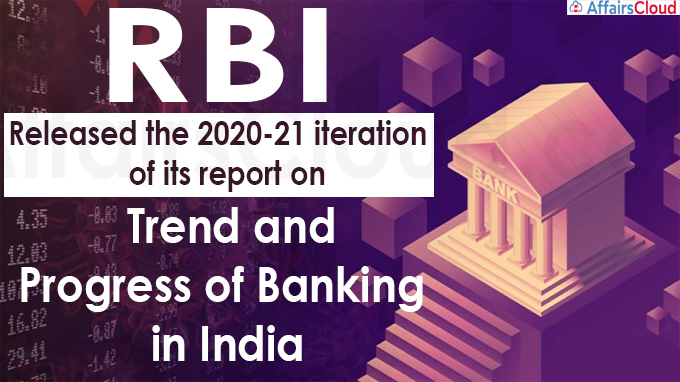 On December 28, 2021, the Reserve Bank of India (RBI) released the ‘Report on Trend and Progress of Banking in India 2020-21’, which presents the performance of the banking sector, including co-operative banks, and non-banking financial companies (NBFCs) during FY21 and FY22 (till December 2021).
On December 28, 2021, the Reserve Bank of India (RBI) released the ‘Report on Trend and Progress of Banking in India 2020-21’, which presents the performance of the banking sector, including co-operative banks, and non-banking financial companies (NBFCs) during FY21 and FY22 (till December 2021).
- The gross non-performing assets (GNPA) ratio of SCBs (Scheduled Commercial Banks) declined from 8.2 percent at end of March 2020 to 6.9 percent at end-September 2021.
- The share of RSA (Restructured Advances) has increased to 1.8 percent at end September 2021 (from 0.8 percent as at end-March 2021 and 0.4 percent at end-March 2020) due to the restructuring scheme 2.0 for retail loans and MSMEs (Micro, Small & Medium Enterprises).
Overall Assessment of the Indian Banking sector:
| Items | Amount Outstanding (At end-March) | At end- September | ||
|---|---|---|---|---|
| 2020 | 2021 (Provisional) | 2021 | ||
| Asset Quality | GNPA ratio (GNPAs as percentage of gross advances) | 8.2% | 7.3% | 6.9% |
| Net NPA ratio (Net NPAs as percentage of net advances) | 2.8 % | 2.4% | – | |
| Profitability | Return on Assets (RoA) | 0.15% | 0.66% | – |
| Capital Adequacy | Capital to risk weighted assets ratio (CRAR) | 14.8% | 16.3% | 16.6% |
| Tier I capital (as percentage of total capital) | 85.5% | 86.8% | – | |
| Financial Inclusion | Credit-deposit ratio | 73.7% | 69.4% | – |
| Balance Sheet Operations | Total Liabilities/Assets | 8.5% | 8.8% | – |
| Deposits | 8.4% | 11.6% | 10.1% | |
| Borrowings | -0.8% | -13.0% | – | |
Report on SCBs:
i.The consolidated balance sheet of Scheduled Commercial Banks (SCBs) expanded in size in 2020-21 despite the COVID-19 and the resultant economic recession.
ii.The CRAR ratio of SCBs strengthened due to higher retained earnings, recapitalisation of PSBs and capital raising from the market by both PSBs and private sector banks.
Report on NBFCs:
The consolidated balance sheets of NBFCs expanded in FY21, driven by credit and investments of non-deposit-taking systemically important NBFCs.
Note – In October 2021, RBI introduced the scale-based regulation framework for NBFCs based on a four-layered structure.
Report on cooperative banks:
i.The cooperative banking segment (both urban and rural) has remained robust throughout the COVID-19 stress.
ii.The increase in deposit insurance from Rs 1 lakh to Rs 5 lakh augmented the share of co-operative depositors’ coverage from 42.7 percent (at end March 2019) to 69.4 percent (at end-March 2021).
iii.Scheduled Urban Co-Operative Bank (SUCB) & Non-Scheduled UCB of UCB faced increasing GNPA ratios, with the latter experiencing sharply higher slippages.
iv.At end-March 2021, there were 98,042 co-operatives, consisting of 1,534 UCBs and 96,508 rural co-operatives.
v.During 2020-21, 25 percent of UCBs’ total funded loans and 32 percent of their NPAs originated from large borrowal accounts as against SCBs’ 51 percent of loans and 66 percent of NPAs.
vi.The profitability of state co-operative banks and district central co-operative banks improved in 2019-20, while their asset quality deteriorated.
Note – The Ministry of Co-operation was created in July 2021 to provide a separate administrative, legal and policy framework for enabling the development of multi-state cooperatives.
Report on CBDC:
i.A central bank digital currency (CBDC) will provides a safe, robust, and convenient alternative to physical cash.
ii.Introduction of the CBDC has a potential to enhance the efficiency of cross border payments.
iii.India’s progress in payment systems will provide a useful backbone to make a state-of-the art CBDC available to citizens and financial institutions.
iv.In comparison with existing forms of money, CBDC can offer benefits to users in terms of liquidity, scalability, acceptance, ease of transactions with anonymity and faster settlement.
General Analysis:
i.The global economic activity and trade has seen a gradual recovery after easing of restrictions from COVID-19.
ii.Asset quality and profitability are the areas that are likely to be most impacted by the COVID-19.
Note- The report is a statutory publication in compliance with Section 36 (2) of the Banking Regulation Act, 1949. Click here to know more about the report
Recent Related News:
In November 2021, RBI has accepted 21 out of 33 recommendations of the Internal Working Group (IWG) that was set up by RBI to review extant ownership guidelines and corporate structure of Indian private sector banks.
RBI has accepted the IWG’s suggestion to increase the limit on promoters’ paid-up voting equity share capital of the bank to 26 percent from the current 15 percent.
About Reserve Bank of India’s (RBI):
Establishment – April 1, 1935
Headquarters – Mumbai, Maharashtra
Governor – Shaktikanta Das
Deputy Governors – Mahesh Kumar Jain, Michael Debabrata Patra, M. Rajeshwar Rao, T. Rabi Sankar




